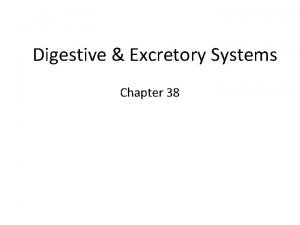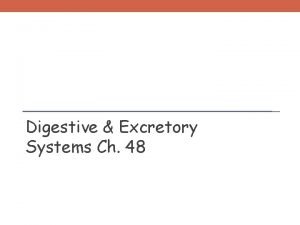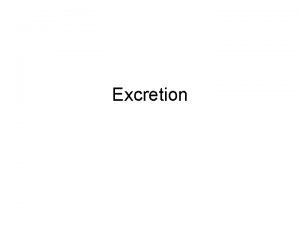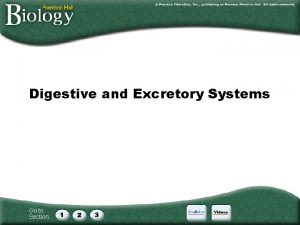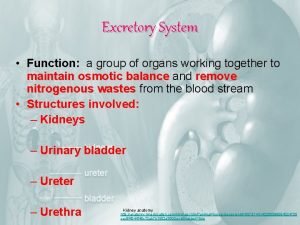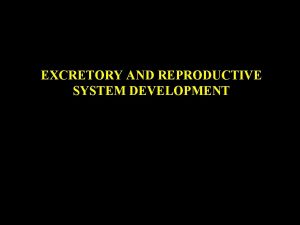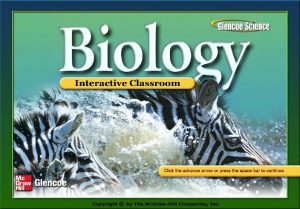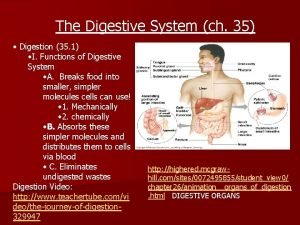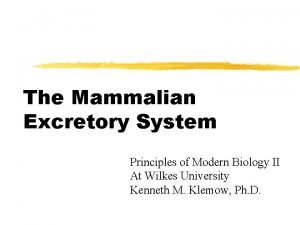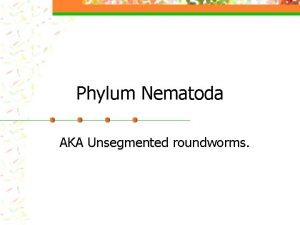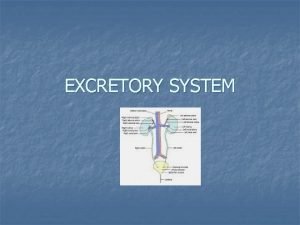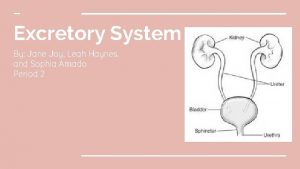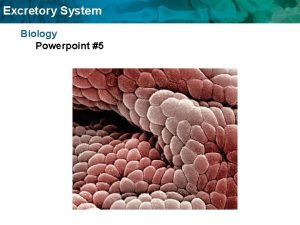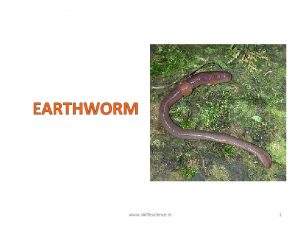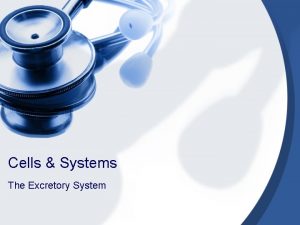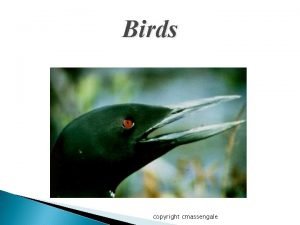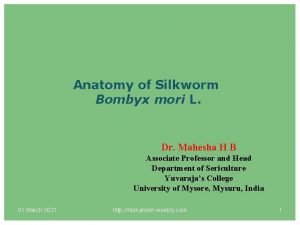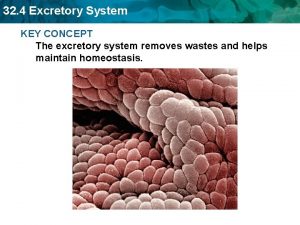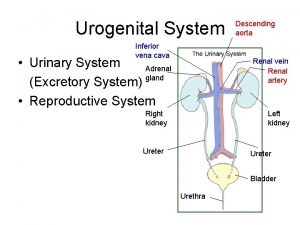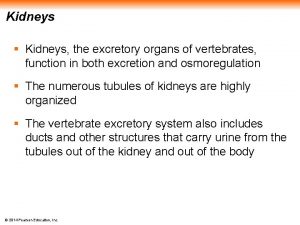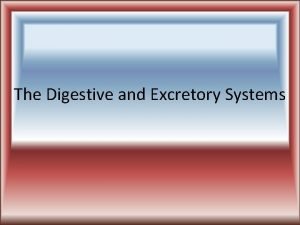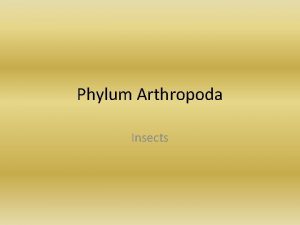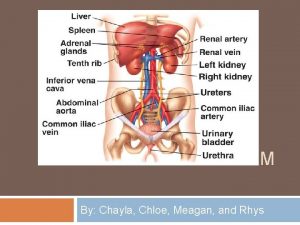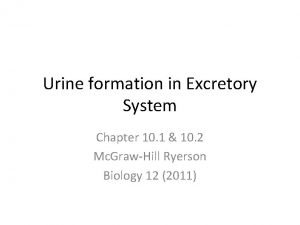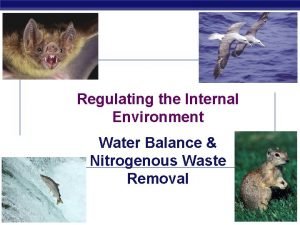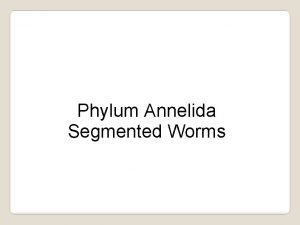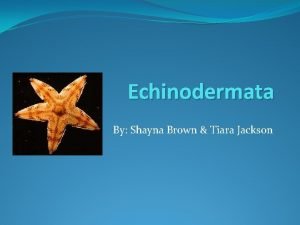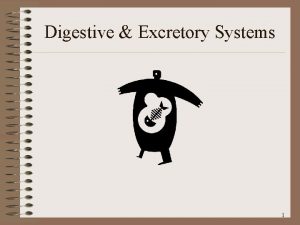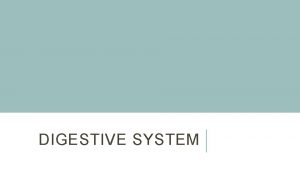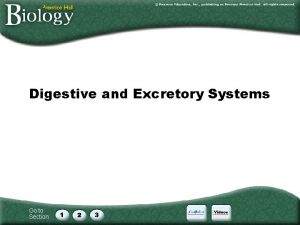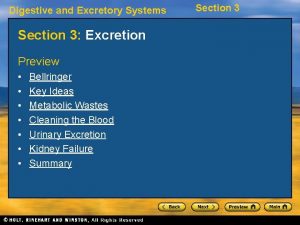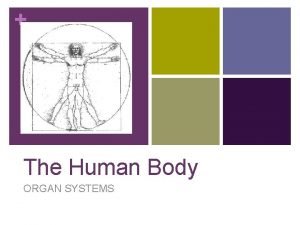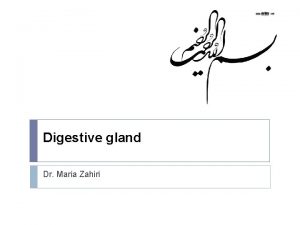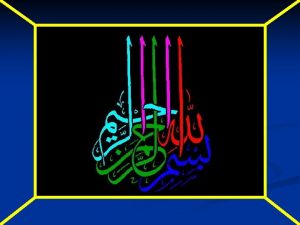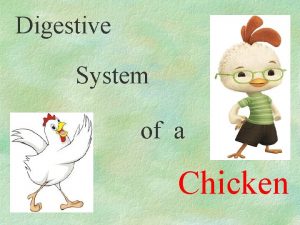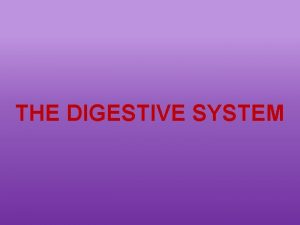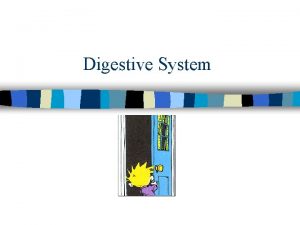Digestive and Excretory Systems Go to Section Do




































- Slides: 36

Digestive and Excretory Systems Go to Section:

Do Now Section 38 -1 Good Food Sense Nutrients are molecules that provide the body with energy and materials for growth. Three kinds of nutrients you eat are called fats, proteins, and carbohydrates—terms you may have already heard. Think about what they may mean. 1. Write a brief description of what you think fats, proteins, and carbohydrates are. 2. Which of these three nutrients do you think should make up the largest part of your diet? Which should make up the smallest part? Arrange three nutrients in order starting from the one that you should eat the most to the one that you should eat the least. 3. Why might it be unwise to eat too much of the nutrient you listed last? Go to Section:

Section Outline Section 38 -1 38– 1 Food and Nutrition A. Food and Energy B. Nutrients 1. Water 2. Carbohydrates 3. Fats 4. Proteins 5. Vitamins 6. Minerals C. Nutrition and a Balanced Diet Go to Section:

Food and Energy • Cells convert the chemical energy stored in food into ATP – When food is burned it releases heat energy, which is measured in calories • A calorie is the amount of heat needed to raise the temperature of 1 gram of water 1 degree Celsius • Dietary Calories refer to the energy stored in food. – One Calorie = 1000 calories • Food also supplies the raw materials used to build and repair body tissues – These raw materials are used to manufacture new biomolecules • Food also contains at least 45 substances that your body cannot manufacture Go to Section:

Concept Map Section 38 -1 Nutrients include Carbohydrates Fats Proteins Vitamins Minerals include are made of are made using include Simple Complex such as Amino acids Fatty Acids Sugars Go to Section: Starches Calcium Glycerol Fat-soluble Watersoluble Iron

Carbohydrates • Main source of energy for the body – Can be simple • Mono and disaccharides – found in honey, fruits, sugar cane – Can be complex • Polysaccharides – starches found in grains, potatoes, veggies • Broken down by the digestive system to be absorbed into the blood and carried throughout the body – If not used immediately, sugars are converted to glycogen, a complex carb and stored in the liver and muscles. • Not all carbs can be broken down – Fiber (cellulose) is used to keep your digestive system functioning properly by helping wastes to move through Go to Section:

Fats • Fats (lipids) formed from fatty acids and glycerol – Needed to form cell membranes, myelin sheaths and some hormones • Extra food is stored as fat to protect body organs and insulate the body • Classified as saturated or unsaturated – Saturated fats • Solid at room temperature • Main cause of high blood pressure, heart disease, obesity and diabetes – Unsaturated fats • Liquid at room temperature • A healthier choice of fat Go to Section:

Proteins • Supply raw materials for growth and repair of skin and muscles • Have regulatory and transport functions – Ex. insulin, hemoglobin • Polymers of amino acids – The body can only synthesize 12 of the 20 amino acids – The other 8 must be ingested • Found in meat, fish, milk, eggs Go to Section:

Figure 38– 8 Food Guide Pyramid Section 38 -1 Fats, Oils, and Sweets (use sparingly) Soft drinks, candy, ice cream, mayonnaise, and other foods in this group have relatively few valuable nutrients. Milk, Yogurt, and Cheese Group (2 -3 Servings) Milk and other dairy products are rich in proteins, carbohydrates, vitamins, and minerals. Vegetable Group (3 -5 servings) Vegetables are a low-fat source of carbohydrates, fiber, vitamins, and minerals. Fats Sugars Go to Section: Meat, Poultry, Fish, Dry Beans, Eggs, and Nut Group (2 -3 servings) These foods are high in protein. They also supply vitamins and minerals. Fruit Group (2 -4 servings) Fruits are good sources of carbohydrates, fiber, vitamins and water. Bread, Cereal, Rice and Pasta Group (6 -11 servings) The foods at the base of the pyramid are rich in complex carbohydrates and also provide proteins, fiber, vitamins, and some minerals.

Section Outline Section 38 -2 38– 2 The Process of Digestion A. The Mouth 1. Teeth 2. Saliva B. The Esophagus C. The Stomach 1. Chemical Digestion 2. Mechanical Digestion D. The Small Intestine Accessory Structures of Digestion E. Absorption in the Small Intestine F. The Large Intestine G. Digestive System Disorders Go to Section:

Figure 38– 10 The Digestive System Section 38 -2 Mouth Pharynx Salivary glands Esophagus Liver Gallbladder (behind liver) Stomach Pancreas (behind stomach) Large intestine Small intestine Rectum Go to Section:

The Mouth • Performs mechanical and chemical digestion – Mechanical – food is changed in size • Performed by the teeth – Chemical – food is changed in composition • Performed by saliva – Contains amylase (an enzyme that breaks down starch) – Also helps to moisten food so it can move easier – Contains lysozyme (an enzyme used to kill bacteria) • The chewed up clump of food is now considered a bolus Go to Section:

The Esophagus • Lined with smooth (involuntary) muscle • As the bolus passes through, contractions, known as peristalsis, squeeze the food through to the stomach • The cardiac sphincter (a thick ring of muscle) closes the esophagus after food has entered the stomach to prevent the contents of the stomach from moving back up. – Is associated with heartburn • A backflow of stomach acid into your esophagus Go to Section:

Stomach • A large muscular sac – Continues mechanical and chemical digestion • Mechanical – churning of bolus and stomach acids to form chyme • Chemical – stomach glands release a variety of secretions – Hydrochloric acid – activates pepsin – Pepsin – breaks down proteins – Any other chemical digestion is stopped until the food reaches the small intestine – Chyme then leaves the stomach through the pyloric valve and enters the small intestine Go to Section:

Small Intestine (SI) • Duodenum (1 st part of the SI) where almost all of the digestive enzymes enter from accessory organs – Shortest part of the SI • Jejunum and Ileum – Where absorption of nutrients occurs – Villi – increase surface area to allow for greater absorption • Contain capillaries and lymph vessels – Products of carbs and proteins are absorbed into the capillaries – Undigested fats and fatty acids are absorbed by the lymph vessels • Water, cellulose and other undigestible substances leave the SI and enter the large intestine Go to Section:

Figure 38– 14 The Small Intestine Section 38 -2 Villus Small Intestine Circular folds Epithelial cells Villi Capillaries Lacteal Vein Artery Go to Section:

Accessory Organs • Pancreas – Produces enzymes, that break down carbs, proteins, lipids and nucleic acids – Also produces sodium bicarbonate to neutralize stomach acids so the enzymes will work • Liver – Produces bile, which dissolves and disperses droplets of fats, so that the enzymes can work on the smaller fat molecules • Gall Bladder – Stores the bile that is produced by the liver Go to Section:

Figure 38– 13 The Liver and the Pancreas Section 38 -2 Liver Gallbladder Duodenum Bile duct Pancreas Pancreatic duct To rest of small intestine Go to Section:

The Digestive Enzymes Section 38 -2 Site Enzyme Role in Digestion Mouth Salivary amylase Breaks down starches into disaccharides Stomach Pepsin Breaks down proteins into large peptides Small intestine (from pancreas) Amylase Continues the breakdown of starch Trypsin Continues the breakdown of protein Lipase Breaks down fat Maltase, sucrase, lactase Breaks down remaining disaccharides into monosaccharides Peptidase Breaks down dipeptides into amino acids. Small intestine Go to Section:

The Large Intestine (LI) • Also known as the colon • Primary function is to absorb water from undigested materials • Rich colonies of bacteria that are present in the LI produce compounds that the body is able to use, like vitamin K. • The concentrated waste material that remains after the water has been removed passes through the rectum, where it is stored until it is eliminated from the body through the anus. Go to Section:

Figure 38– 10 The Digestive System Section 38 -2 Mouth Pharynx Salivary glands Esophagus Liver Gallbladder (behind liver) Stomach Pancreas (behind stomach) Large intestine Small intestine Rectum Go to Section:

Video 1 Human Digestion Click the image to play the video segment.

Interest Grabber Section 38 -3 Your Body’s Filter Have you ever seen a water-purification system attached to a faucet? This system removes impurities from the water such as arsenic or other chemicals that can be harmful to people. As water passes through the filters contained in the system, the impurities are trapped on the surface of the filters. Eventually, the water that comes out of this purifier is free of the impurities. 1. Your body has its own system for filtering blood. Why might the blood in your body need to be filtered? 2. What organ(s) do you think filters your blood? 3. How do you think the filtered materials leave your body? Go to Section:

Section Outline Section 38 -3 38– 3 The Excretory System A. Functions of the Excretory System B. The Kidneys 1. Kidney Structure 2. Filtration 3. Reabsorption 4. Kidney Stones C. Control of Kidney Function D. Homeostasis by Machine Go to Section:

Functions of the Excretory System • Every cell in the body produces metabolic wastes as a result of maintaining homeostasis – Wastes such as urea, excess salts and carbon dioxide must be removed from the body • The skin, lungs and liver are three organs that assist in excretion – The skin excretes excess salts, water and a small amount of urea – The lungs excrete carbon dioxide – The liver takes excess amino acids from the blood stream and converts them to useful compounds • In the process of conversion, poisonous nitrogen compounds are created, which are turned into urea • Urea is then removed from the bloodstream by the body’s principal organs of excretion – the kidneys Go to Section:

Kidneys • The kidneys have many roles – Remove waste products from the blood – Maintain blood p. H – Regulate the water content of the blood and therefore blood volume • As waste-laden blood enters the kidney from the renal artery, it removes urea, excess water and other wastes and passes them to the ureter • The clean, filtered blood leaves the kidney through the renal vein and returns to circulation Go to Section:

Kidney Structure • Two distinct regions – Renal cortex – outer part • Contains nephrons – the functional units of the kidney – Each one is a small, independent unit – One part of a nephron, the loop of Henle, descend into the inner part of the kidney – Renal medulla – inner part Go to Section:

Nephron • Each nephron has its own blood supply – An arteriole, a venule and a network of capillaries • Each nephron releases fluid into a collecting duct, which leads to the ureters • Blood purification involves two distinct processes: filtration & reabsorption – Filtration – takes place in the glomerulus, a small network of capillaries encased in Bowman’s capsule – Reabsorption – most of the material (water, amino acids, glucose) removed from Bowman’s capsule is taken back into the blood – The material that remains is urine (urea, salts, water) and is concentrated in the loop of Henle, where water is conserved and the volume of urine is minimized. – Urine is then stored in the bladder until it is released from the body through the urethra Go to Section:

The Urinary System Section 38 -3 Vein Kidney (Cross Section) Kidney Cortex Medulla Ureter Urinary bladder Urethra Go to Section: Artery

Figure 38– 17 Structure of the Kidneys Section 38 -3 Kidney Nephron Bowman’s capsule Cortex Medulla Renal artery Capillaries Glomerulus Renal vein Ureter Collecting duct Vein To the bladder Artery Loop of Henle Go to Section: To the ureter

The Nephron Section 38 -3 Reabsorption Filtration Most filtration occurs in the glomerulus. Blood pressure forces water, salt, glucose, amino acids, and urea into Bowman’s capsule. Proteins and blood cells are too large to cross the membrane; they remain in the blood. The fluid that enters the renal tubules is called the filtrate. Go to Section: As the filtrate flows through the renal tubule, most of the water and nutrients are reabsorbed into the blood. The concentrated fluid that remains is called urine.

Control of Kidney Function • The activity of the kidneys is controlled by the blood itself. • Water is absorbed into the blood from the digestive system. – The concentration of water in the blood increases. • Without your kidneys, the increase in water conc. would force water into cells and tissues, causing your body to swell – As the amount of water in the blood increases, the rate of water reabsorption in the kidneys decreases. • Less water is returned to the blood and the excess water is sent to the bladder. • With an increase in salt, your kidneys return less salt to the blood, and send the excess salt to the bladder. Go to Section:

Disease • Kidney Stones – Substances such as calcium, magnesium or salts in the urine crystallize and form stones – These stones may block the ureter, causing great pain – Often treated using ultrasound waves • The stones gets pulverized into smaller fragments, which are then excreted in the urine. Go to Section:

Homeostasis by Machine • Dialysis – Blood is removed from the body through a tube and pumped through special tubing that acts like nephrons – Wastes diffuse out of the blood and into a fluid-filled chamber – The purified blood is then returned to the body Go to Section:

Figure 38– 19 Kidney Dialysis Section 38 -3 Blood in tubing flows through dialysis fluid Blood pump Vein Artery Used dialysis fluid Shunt Air detector Go to Section: Dialysis machine Fresh dialysis fluid Compressed air

Video 2 Kidney Function Click the image to play the video segment.
 Section 38-2 the process of digestion answer key
Section 38-2 the process of digestion answer key Digestive and excretory system
Digestive and excretory system Section 38-3 the excretory system
Section 38-3 the excretory system Section 38-3 the excretory system
Section 38-3 the excretory system Excretory system parts and functions
Excretory system parts and functions Excretory and integumentary system
Excretory and integumentary system Excretory and reproductive system
Excretory and reproductive system Chapter 35 section 1 the digestive system
Chapter 35 section 1 the digestive system Chapter 35 section 1 the digestive system answer key
Chapter 35 section 1 the digestive system answer key Ekskresi
Ekskresi Urinary structure
Urinary structure Excretory system of phylum nematoda
Excretory system of phylum nematoda What does the excretory system do
What does the excretory system do Excreatory organ
Excreatory organ Excretory system facts
Excretory system facts What is the main function of the excretory system
What is the main function of the excretory system Lungs excretory function
Lungs excretory function Reproductive system of earthworm
Reproductive system of earthworm Fetal pig excretory system diagram
Fetal pig excretory system diagram 5 facts about the excretory system
5 facts about the excretory system Copyright
Copyright Vertical
Vertical Process of excretion
Process of excretion Excretory system quizizz
Excretory system quizizz Vena cava urinary system
Vena cava urinary system Excretory system of vertebrates
Excretory system of vertebrates Excretory system song
Excretory system song Chapter 20 urinary/excretory system
Chapter 20 urinary/excretory system Digestive system objectives
Digestive system objectives Subphylum of grasshopper
Subphylum of grasshopper Excretory system
Excretory system Excretory system
Excretory system Mammalian excretory system
Mammalian excretory system Mammalian excretory system
Mammalian excretory system Annelida characteristics
Annelida characteristics Malpighian tubules
Malpighian tubules Excretory organs in echinoderms
Excretory organs in echinoderms
